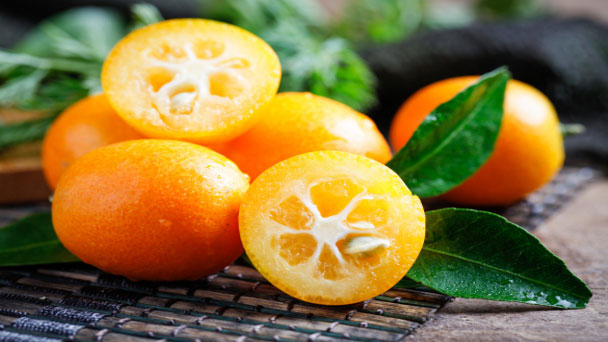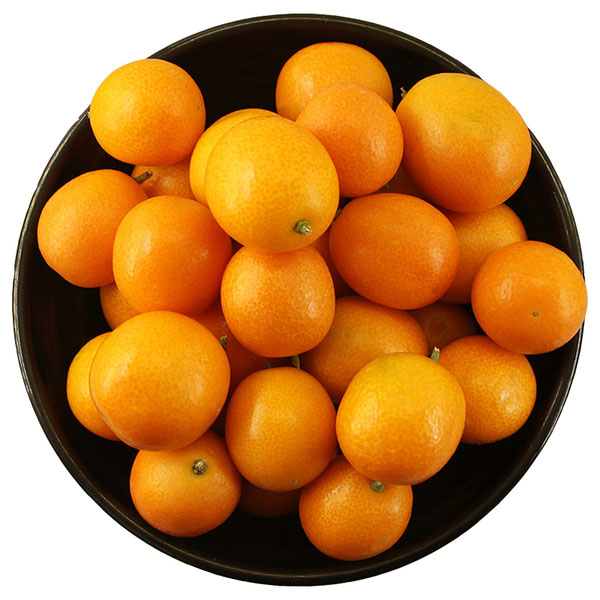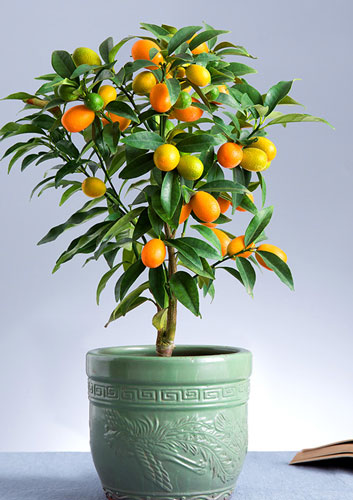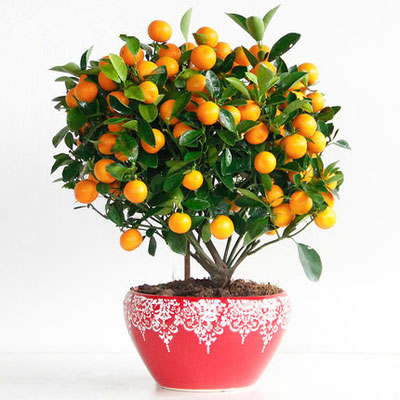Kumquat Profile
Written by Iris
Oct 19 2021

Kumquat is a tiny citrus that tastes like an orange but is rectangular in shape and about the size of a cocktail olive. They have some advantages for gardeners in colder areas because they will grow in areas where oranges and other citrus cannot grow. The sweet, sour fruit doesn't need to be peeled. The skin is so thin that you can stuff the whole kumquat into your mouth and swallow it in one mouthful.

Place the paper towel with the seeds in a resealable sandwich bag. Keep the seeds wrapped inside the towel. Squeeze all of the air out of the bag before you seal it because air left in the bag will make the paper towel and the seeds dry out and they will be less likely to germinate.
Keep the bag in a warm area for 1 week. Place the bag on a windowsill, a seedling mat, or above a heater to keep it warm. The seeds do not need direct sunlight right now, but they do need warmth and humidity.
Fill cell pots to the top with a potting mix of soil, organic matter, and sand. Kumquats need well-draining soil, so create an even mix of sand, potting soil, and compost in each cell pot. Prepare enough pots for the number of seeds that you've placed in the bag.
Bury 1 seed in each cell 1⁄2 in (13 mm) below the surface of the potting mix.
Soak the cut end of the branch in a rooting hormone for up to 5 days. Place the end of the cutting into the rooting hormone mixed with water. Follow the instructions on the packaging to make the correct hormone solution. Let the cutting absorb the hormone from the solution.
Stick the branch 1.5 in (3.8 cm) deep into a medium pot with damp soil. Make a small hole in a potting medium or equal parts soil, sand, and compost with your finger or the end of a pencil. Place the cutting in the hole you've made and firm up the soil so it can stand on its own.
Transplant trees in early spring or fall. The warm months of summer are peak growing seasons for kumquat trees, so wait until the cooler months if you need to move your tree. Prepare soil in a larger pot or in the ground and carefully remove the kumquat tree from its old container. Replant the tree so the top of the root ball is even with the soil.
Read next: How to Grow & Care for Kumquat Tree
Citrus japonica 'Nagami', the most popular type of kumquat, is oval in shape and has deep-orange fruit with two to five seeds per kumquat.
Citrus japonica 'Meiwa' is larger than 'Nagami', has a sweeter pulp and juice, and is nearly seedless.
Citrus japonica 'Marumi' is round and bears orange-like fruits. All varieties grow nicely in a container.
Citrus japonica 'Centennial Variegated' is a compact form growing 7 to 10 feet tall with leaves and fruit that are both variegated.
Although indoor plants are less susceptible to pests, be sure to keep an eye out for aphids, scale and mealybug infestations. Remove visible bugs and treat with an insecticide soap or horticultural oil. Controlling these pests will protect the tree from sooty mold fungus.
Kumquat trees are self-pollinating, but because indoor trees don't have butterflies and bees to help pollinate the flowers, your tree may stop producing fruits. You can help pollinate the tree by gently shaking or flicking the flowers to help spread pollen, advises the University of Minnesota Extension.
There's a downside to this, though. The flesh of the kumquat is highly sensitive to temperature fluctuations. If you stock up on kumquats to have them on hand, bring the whole batch inside and place them in the refrigerator together. If you remove a few, store them separately. It’s a good idea to keep a whole bunch in the fridge and a few others on the counter, for quick snacks.
The kumquat will last longer stored whole and unwashed. Wash them just before you eat them.
Keep in mind that kumquats are sometimes treated with wax to improve the fruit’s appearance. If you’re storing whole kumquats, you may want to remove the thin layer of wax, which can make your mouth a bit sticky.
Kumquat PictureKumquat InfoEcological Habits of KumquatKumquat Distribution AreaHow to Grow and Care for KumquatHow to Grow KumquatHow to Care for KumquatUses of KumquatVarieties of KumquatKumquat Common Pests/DiseasesKumquat HarvestingKumquat StoringKumquat Companion Plants
Kumquat Picture
Kumquat Info
| Botanical Name | Citrus japonica |
| Common Name | Kumquat |
| Plant Type | Flowering broadleaf fruit tree |
| Mature Size | 8 to 15 feet tall, 12 feet wide; smaller when grown in pots |
| Sun Exposure | Full sun |
| Soil Type | Moist, well-drained loamy soil |
| Soil pH | Slightly acidic to neutral (6.0 to 7.0) |
| Bloom Time | Late spring to early summer |
Ecological Habits of Kumquat
With dense, dome-shaped crowns, a tightly branching habit, small neat leaves, modest root systems and deliciously fragrant flowers, cumquats make excellent subjects for small and potted gardens.Kumquat Distribution Area
The kumquat plant is native to China. The earliest historical reference to kumquats appears in Imperial literature from the 12th century. They have long been cultivated in other parts of East Asia (Japan and Taiwan), South Asia (India), and Southeast Asia (especially the Philippines).
How to Grow and Care for Kumquat
How to Grow Kumquat
- With Seeds
Place the paper towel with the seeds in a resealable sandwich bag. Keep the seeds wrapped inside the towel. Squeeze all of the air out of the bag before you seal it because air left in the bag will make the paper towel and the seeds dry out and they will be less likely to germinate.
Keep the bag in a warm area for 1 week. Place the bag on a windowsill, a seedling mat, or above a heater to keep it warm. The seeds do not need direct sunlight right now, but they do need warmth and humidity.
Fill cell pots to the top with a potting mix of soil, organic matter, and sand. Kumquats need well-draining soil, so create an even mix of sand, potting soil, and compost in each cell pot. Prepare enough pots for the number of seeds that you've placed in the bag.
Bury 1 seed in each cell 1⁄2 in (13 mm) below the surface of the potting mix.
- With Cuttings
Soak the cut end of the branch in a rooting hormone for up to 5 days. Place the end of the cutting into the rooting hormone mixed with water. Follow the instructions on the packaging to make the correct hormone solution. Let the cutting absorb the hormone from the solution.
Stick the branch 1.5 in (3.8 cm) deep into a medium pot with damp soil. Make a small hole in a potting medium or equal parts soil, sand, and compost with your finger or the end of a pencil. Place the cutting in the hole you've made and firm up the soil so it can stand on its own.
Transplant trees in early spring or fall. The warm months of summer are peak growing seasons for kumquat trees, so wait until the cooler months if you need to move your tree. Prepare soil in a larger pot or in the ground and carefully remove the kumquat tree from its old container. Replant the tree so the top of the root ball is even with the soil.

How to Care for Kumquat
- Light
- Soil
- Water
- Temperature and Humidity
- Fertilizer
- Pruning
Read next: How to Grow & Care for Kumquat Tree

Uses of Kumquat
Cumquats are known for their very tart citrus flavour and are most commonly used in jams, marmalades and preserves. Many people also enjoy eating cumquats whole, including the fragrant skin, which can be sweeter than the flesh itself. There are several different varieties of cumquats, also called kumquats, including oval fruited ‘Nagami’ and round ‘Marumi’. There's also a cumquat with both variegated leaves and fruit. Cumquats can also be very decorative trees, with their white fragrant flowers and brightly coloured fruit covering the trees from winter to early spring. Cumquats are often grown purely as ornamental trees, however marmalade makers will appreciate a basket of fruit.Varieties of Kumquat
Kumquat trees are produced by grafting fruit-bearing branches onto the rootstock of oranges and grapefruits. If kumquat seeds are planted, they will not produce viable trees.Citrus japonica 'Nagami', the most popular type of kumquat, is oval in shape and has deep-orange fruit with two to five seeds per kumquat.
Citrus japonica 'Meiwa' is larger than 'Nagami', has a sweeter pulp and juice, and is nearly seedless.
Citrus japonica 'Marumi' is round and bears orange-like fruits. All varieties grow nicely in a container.
Citrus japonica 'Centennial Variegated' is a compact form growing 7 to 10 feet tall with leaves and fruit that are both variegated.
Kumquat Common Pests/Diseases
Kumquats are prone to root rot if the soil is too soggy. Be sure to empty the tray under the pot after watering so that the soil is not soggy. Indoor citrus is also prone to sooty mold fungus, an organism that feeds on the honeydew of certain insects.Although indoor plants are less susceptible to pests, be sure to keep an eye out for aphids, scale and mealybug infestations. Remove visible bugs and treat with an insecticide soap or horticultural oil. Controlling these pests will protect the tree from sooty mold fungus.
Kumquat trees are self-pollinating, but because indoor trees don't have butterflies and bees to help pollinate the flowers, your tree may stop producing fruits. You can help pollinate the tree by gently shaking or flicking the flowers to help spread pollen, advises the University of Minnesota Extension.

Kumquat Harvesting
The harvesting time for most varieties begins from November through January, while for others, it’s from December to April. The fruit is ripe when it's slightly soft and deep orange. Pick the fruit using scissors or pruning snips to avoid damaging the plant. You can also trim the fruit along with a small piece of the branch.Kumquat Storing
Kumquats keep well when refrigerated.There's a downside to this, though. The flesh of the kumquat is highly sensitive to temperature fluctuations. If you stock up on kumquats to have them on hand, bring the whole batch inside and place them in the refrigerator together. If you remove a few, store them separately. It’s a good idea to keep a whole bunch in the fridge and a few others on the counter, for quick snacks.
The kumquat will last longer stored whole and unwashed. Wash them just before you eat them.
Keep in mind that kumquats are sometimes treated with wax to improve the fruit’s appearance. If you’re storing whole kumquats, you may want to remove the thin layer of wax, which can make your mouth a bit sticky.
Kumquat Companion Plants
Kumquat trees can be prime targets of insect pests, but you can plant marigolds, petunias, and borage nearby, and they will help act as natural pest deterrents. You can also enlist some other plant helpers: Yarrow, dill, and fennel attract lacewings and ladybugs, which love to eat aphids.Latest Updated
- Benefits of Bugleweed - 7 Science-backed Health Benefits
- Bugleweed Dangers & Side Effects - Is It Poisonous?
- How to Plant Evergreen Trees - What You Should Know
- When to Plant Evergreens - Grow Guide for Evergreen Trees
- 12 Wonderful Evergreen Shrubs for Your Garden
- 12 Popular Evergreen Plants with Pictures for Beginners
- When And How To Prune A Lilac Bush Like a Pro
- How to Grow & Care for Lilac Vine (Hardenbergia Violacea)
- Japanese Lilac Tree (Syringa Reticulata) Care & Propagation Guide
- Shumard Oak Pros and Cons - What to Know
Popular Articles
- Winter maintenance of Antirrhinum Majus
- How to Grow Terminalia Mantaly Tree
- How to Grow and Care for Crossostephium Chinense
- How to grow Antirrhinum Majus in spring
- Peristeria Elata (Dove Orchid) Profile: Info & Care Guide
- Underwatered Snake Plant (Sansevieria Trifasciata) - Signs And How To Fix
- How to Care for Brazilian Jasmine Plant (Mandevilla Sanderi)
- How to Grow & Care for Graptopetalum Purple Delight in Summer
- Rosa Chinensis (China Rose): Plant Growing & Care Tips
- How to Care for Baby Sun Rose (Aptenia Cordifolia)
